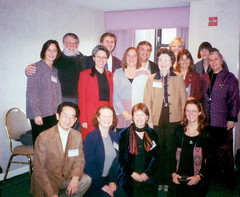Symposium on Education and Training, World Congress of Music Therapy
By Barbara Wheeler & Denise Grocke

Middle row: Mechtild Langenberg, Connie Isenberg-Grzeda, Barbara Hesser, Marilyn Sandness, Mayra Hugo, Chava Sekeles.
Front row: Fumio Kuribayashi, Denise Grocke, Helen Odell-Miller, Inge Nygaard Pedersen
A Symposium on Education and Training was held at the beginning of the World Congress to address the following objectives: (a) to establish model guidelines for training courses world-wide, at entry level to the profession; (b) to address “advanced” levels of training (i.e., beyond entry level); and (c) to create a forum for discussion and debate of education and training issues, leading to Guidelines for Music Therapy Education and Training. There were 15 participants representing nine countries. They were:
- Denise Erdonmez Grocke (Australia),
- Chair and Convener; Kenneth Bruscia (USA);
- Cheryl Dileo (USA);
- Barbara Hesser (USA);
- Fumio Kuribayashi (Japan);
- Mayra Hugo (Uruguay);
- Connie Isenberg-Grzeda (Canada);
- Mechtild Jahn-Langenberg (Germany);
- Inge Nygaard Pedersen (Denmark);
- Helen Odell-Miller (UK);
- Marilyn Sandness (USA);
- Chava Sekeles (Israel);
- Helen (Tyler) Patey (UK);
- Tony Wigram (Denmark and UK); and
- Barbara Wheeler (USA).
Denise Grocke writes (in her column as WFMT President, part of the current interview series) the following about the Symposium on Education and Training that she organized at the World Congress:
I had been the Chair of the Education and Training Commission from 1993-1999, and I instigated a 2-day symposium of the Education Commission, to address the issue of whether the WFMT should create its own Guidelines for Education Training Programs. A group of 16 invited academics from different countries gave presentations about the content and extent of their training, including didactic components and clinical training. We came to the point where we needed to decide if we would establish Guidelines for the world, and I recall Professor Ken Bruscia wisely saying “let’s keep them brief, and not try to work out hours and competencies.” The WFMT Guidelines were then crafted, and were just one-page in length (see attached). I also recall the excitement when the delegates to the Education Symposium found that the term “bio-psycho-social’ was understood and used throughout the world.
Barbara Wheeler writes (in her Memories of this Congress, also part of the current series):
The symposium sponsored by the Commission on Education and Training that preceded the conference was important to me and, I think, to the development of music therapy education around the world. Denise Erdonmez Grocke had invited me to attend the symposium that her commission was sponsoring. I believe she asked me because of my experience as an educator and so that I could help with the record keeping; perhaps she also had in mind that I might take a larger role in the work of that commission. This meeting resulted in Guidelines for Education and Training, intended to guide music therapy educators around the world. Denise and I published information about the Symposium in Music Therapy Perspectives (Wheeler, B. L., & Grocke, D. E. (2001). Report of the World Federation of Music Therapy Commission on Education, Training, and Accreditation Symposium. Music Therapy Perspectives, 19, 63-67.) After this experience, I was appointed Chair of the Commission on Education and Training and enjoyed the next years of my involvement in WFMT through this Commission and membership on the WFMT Council.
The Guidelines for Education and Training were established at this Symposium.
Sources:
- Wheeler, B, & Erdonmez Grocke, D. (2001). Report form the Education, training, and accreditation education symposium. Music Therapy Perspectives, 19 (1), 62-67. (pdf, 970KB) Republished here with the kind permission of the American Music Therapy Association.
- World Federation for Music Therapy (1999). Guidelines for music therapy education and training. Washington, D.C.: Education Symposium, World Congress of Music Therapy. (pdf, 60KB) Republished here with the kind permission of the World Federation for Music Therapy.

